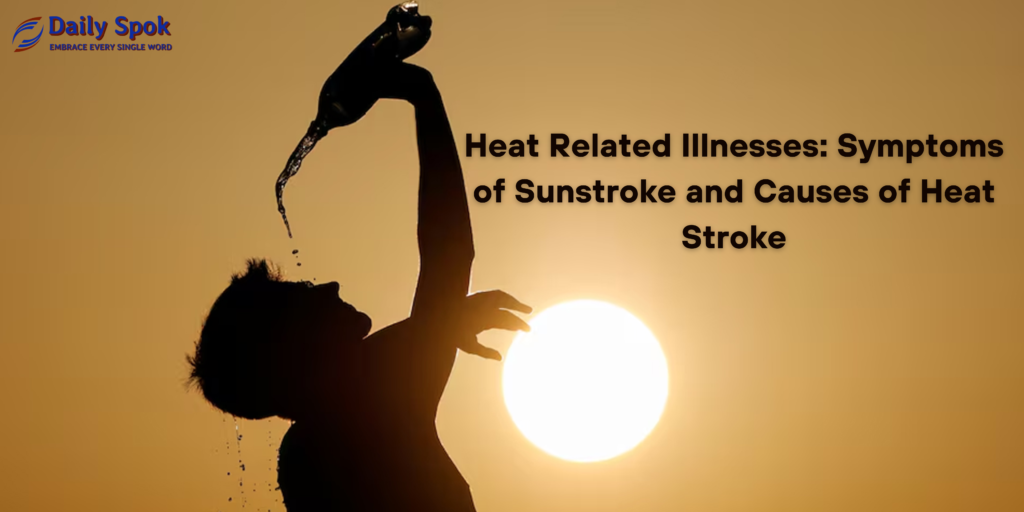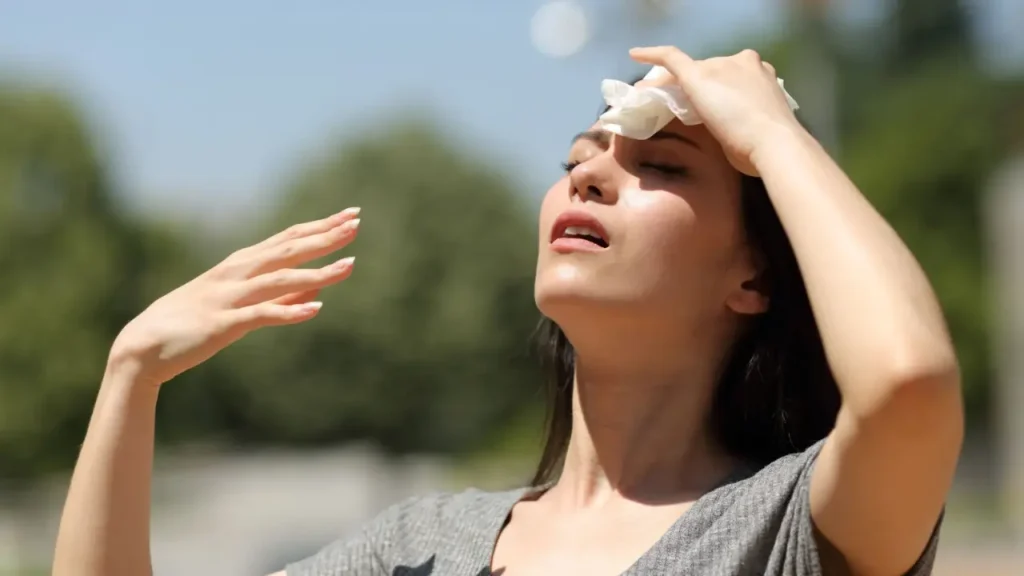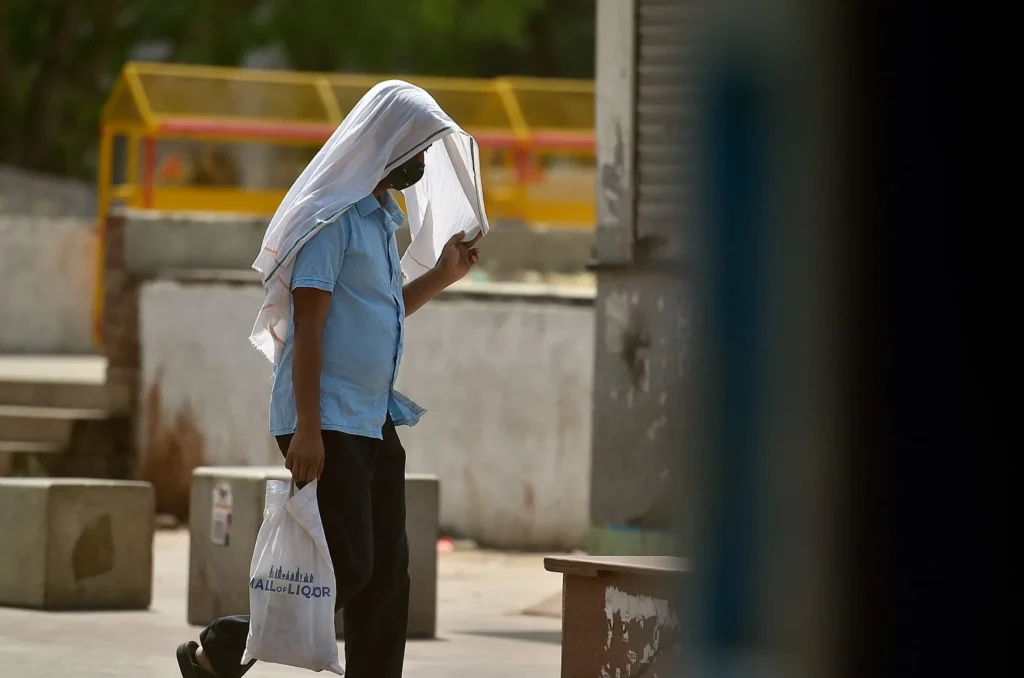
As summer temperatures rise, the risk of heat-related illnesses also rises. Among these, sunstroke and heat stroke are particularly serious conditions that can have severe health consequences if not promptly recognized and treated. Understanding the symptoms of sunstroke and the causes of heat stroke is essential for preventing and managing these potentially life-threatening conditions. Understanding the various types, symptoms, causes, treatments, and preventive measures of heat-related illnesses is crucial, especially as global temperatures continue to rise.
Types of Heat-Related Illnesses
Heat Cramps
- Description: Painful muscle spasms, usually in the legs or abdomen, caused by heavy exertion in hot environments.
- Symptoms: Muscle pain and spasms, heavy sweating.
Heat Syncope
- Description: Fainting or dizziness that occurs with prolonged standing or sudden rising from a sitting or lying position.
- Symptoms: Lightheadedness, dizziness, fainting.
Heat Exhaustion
- Description: A condition resulting from excessive heat exposure and dehydration.
- Symptoms: Heavy sweating, weakness, cold and clammy skin, fast and weak pulse, nausea or vomiting, muscle cramps, tiredness, dizziness, headache.
Heat Stroke
- Description: A severe, life-threatening condition where the body’s temperature regulation system fails.
- Symptoms: High body temperature (above 104°F or 40°C), hot and dry skin, rapid and strong pulse, confusion, seizures, unconsciousness.
Symptoms of Sunstroke

Sunstroke, also known as heat exhaustion, occurs when the body overheats due to prolonged exposure to high temperatures and insufficient hydration. It is often the precursor to heat stroke and presents with a range of symptoms that can escalate if not addressed. Key symptoms of sunstroke include:
Heavy Sweating:
- One of the earliest signs of sunstroke.
- The body sweats profusely in an attempt to cool itself down.
Weakness and Fatigue:
- Overheating can cause a significant drop in energy levels.
- Individuals may feel unusually tired or exhausted.
Dizziness or Fainting:
- Reduced blood flow to the brain due to dehydration and overheating can cause lightheadedness.
- In severe cases, it may lead to fainting.
Muscle Cramps:
- Often occur in the legs and abdomen.
- Caused by the loss of essential salts and fluids through excessive sweating.
Nausea or Vomiting:
- The body’s response to overheating can include gastrointestinal distress.
- Feelings of nausea can escalate to vomiting in some cases.
Rapid Heartbeat:
- The heart works harder to pump blood to the skin’s surface for cooling.
- This can result in a noticeably faster pulse.
Headache:
- Dehydration and heat stress can cause persistent, throbbing headaches.
- Headaches may be accompanied by a general feeling of discomfort.
In Hot Weather, Cool, Moist Skin that Gives you Goosebumps:
- Despite the heat, the skin may feel cool and clammy.
- This can be misleading but indicates the body’s struggle to regulate its temperature.
Irritability or Confusion:
- Cognitive functions can be affected, leading to irritability, confusion, or disorientation.
- In severe cases, this can progress to more severe mental status changes.
Dark Urine:
- A sign of dehydration.
- Urine may appear darker than usual due to reduced fluid intake and increased loss through sweat.
Recognizing these symptoms early is crucial. If someone is experiencing sunstroke, it’s important to move them to a cooler place, hydrate them, and allow them to rest.
Causes of Heat Stroke

Heat stroke is a severe, life-threatening condition that occurs when the body’s temperature regulation system fails, causing the core body temperature to rise to dangerous levels (typically above 104°F or 40°C). This can lead to damage to the brain and other vital organs if not treated promptly. Understanding the causes of heat stroke is crucial for prevention and early intervention. Here are the primary causes:
Prolonged Exposure to High Temperatures:
- Spending extended periods in hot environments, especially during peak sunlight hours, can overwhelm the body’s ability to cool itself.
- This is particularly common during heat waves or in regions with consistently high temperatures.
Strenuous Physical Activity in the Heat:
- Engaging in intense exercise or labor in hot and humid conditions increases body heat production.
- Athletes, outdoor workers, and military personnel are particularly at risk.
Dehydration:
- Insufficient fluid intake reduces the body’s ability to sweat and regulate temperature.
- Dehydration is a significant risk factor as it impairs the body’s natural cooling mechanisms.
Wearing Excessive Clothing:
- Wearing heavy or tight clothing that doesn’t allow sweat to evaporate can trap heat and raise body temperature.
- This is a common issue in certain occupational settings or with protective gear.
Alcohol Consumption:
- Alcohol can interfere with the body’s ability to regulate temperature and can also lead to dehydration.
- Consuming alcohol in hot weather increases the risk of heat stroke.
Certain Medications:
- Some drugs affect the body’s heat regulation by altering hydration levels, blood flow, or sweating capacity.
- Examples include diuretics, antihistamines, beta-blockers, and antidepressants.
Health Conditions:
- Chronic illnesses such as heart disease, obesity, diabetes, and respiratory conditions can impair the body’s ability to handle heat.
- Fever and infections can also predispose individuals to heat stroke.
Age:
- Infants and young children are more susceptible due to their immature temperature regulation systems.
- The elderly are at higher risk due to diminished ability to sweat, reduced cardiovascular function, and often a decreased sense of thirs
Lack of Acclimatization:
- Sudden exposure to high temperatures without gradual adaptation can increase the risk of heat stroke.
- This is common among travelers or new residents in hot climates.
Environmental Factors:
- High humidity levels prevent sweat from evaporating efficiently, reducing the body’s ability to cool itself.
- Urban environments with concrete and asphalt can create “heat islands,” exacerbating exposure to high temperatures.
Treatment of Sunstroke
Sunstroke, also known as heat exhaustion, is a condition that occurs when the body overheats due to prolonged exposure to high temperatures and insufficient hydration. Immediate and appropriate treatment is crucial to prevent sunstroke from progressing to heat stroke, which is a more severe and potentially life-threatening condition. Here are detailed steps for treating sunstroke:
Immediate Actions
Move to a Cooler Environment:
Move to a Cooler Environment:
- Find Shade or Go Indoors: Immediately move the person to a shaded area or an air-conditioned space to help lower their body temperature.
- Ventilation: Improve airflow by using fans or opening windows if indoors.
Rest:
- Lie Down: Have the person lie down and rest to reduce exertion and allow the body to cool.
- Elevate Legs: Raise the legs slightly to improve blood circulation and reduce the risk of fainting.
Hydrate:
- Water and Electrolytes: Encourage the person to drink plenty of water or sports drinks that replenish electrolytes. Avoid caffeine and alcohol, as they offer dehydration.
- Small Sips: If the person feels nauseated, they should take small sips of water instead of large gulps to avoid vomiting.
Cool the Body:
- Wet Cloths and Cool Showers: Apply cool, wet cloths to the skin, or have the person take a cool (not cold) shower to help lower body temperature.
- Ice Packs: Place ice packs or cold packs on areas where blood vessels are close to the skin, such as the neck, armpits, groin, and back. Prevent placing ice directly on the skin to avoid frostbite.
- Fan Use: Use a fan to help with evaporation and cooling.
Remove Excess Clothing:
- Light Clothing: Remove unnecessary clothing and dress the person in lightweight, loose-fitting, and light-colored clothes to help dissipate heat.
Monitoring
Check Vital Signs:
- Pulse and Breathing: Monitor the person’s pulse and breathing rate to ensure they are stable. A rapid heartbeat or irregular breathing may indicate a more severe condition.
- Temperature: Keep track of the person’s body temperature if a thermometer is available.
Observe for Improvement:
- Symptom Relief: Symptoms should start improving within 30 minutes. If there is no improvement, the situation may require medical attention.
When to Seek Medical Help
No Improvement:
- Persistent Symptoms: If the symptoms do not improve or worsen after initial treatment measures, seek medical help immediately.
Signs of Heat Stroke:
- Severe Symptoms: If the person develops symptoms of heat stroke, such as very high body temperature (above 104°F or 40°C), confusion, seizures, loss of consciousness, or hot and dry skin, call emergency services right away.
Severe Reactions:
- Medical Attention: Seek urgent medical care if the person experiences fainting, rapid or weak pulse, or persistent vomiting.
Preventive Measures for Sunstroke
Preventing sunstroke involves taking proactive steps to stay cool and hydrated, especially during hot weather or physical activities in the sun:
Stay Hydrated:
- Regular Drinking: Drink plenty of water throughout the day, even if you do not feel thirsty. Consume electrolyte solutions if engaging in prolonged physical activity.
Limit Sun Exposure:
- Peak Hours: Avoid spending extended periods in the sun during the hottest parts of the day, typically from 10 AM to 4 PM.
- Shade and Breaks: Take frequent breaks in shaded or air-conditioned areas to cool down.
Wear Appropriate Clothing:
- Light and Breathable: Opt for lightweight, loose-fitting, and light-colored clothing to reflect sunlight and facilitate air circulation.
- Protective Gear: Wear a wide-brimmed hat, sunglasses, and apply sunscreen with a high SPF to protect against sunburn.
Gradual Acclimatization:
- Adaptation: Gradually increase exposure to hot weather over several days to allow the body to acclimate to higher temperatures.
Monitor Weather Conditions:
- Heat Advisories: Stay informed about heat advisories and plan outdoor activities accordingly.
Special Care for Vulnerable Individuals:
- Extra Attention: Pay close attention to children, the elderly, and those with chronic health conditions, as they are more susceptible to heat-related illnesses.
Heat Waves in India: A Growing Concern

In India’s millions of people across the country are harmed by these prolonged periods of extraordinarily high temperatures, which are growing more common due to urbanization and climate change.
Look at some Breaking News Headlines of India 2024
- Heat wave kills at least 56 in India, nearly 25,000 heat stroke cases, from March-May.
- Heat stroke death: 61 killed as brutal heatwave grips several States in north.
- 80 deaths due to confirmed and suspected heat strokes, 605 deaths due to cardiovascular diseases in May: Health Ministry data.
- Heat kills at least 15 in India as temperatures near 50C.
- BackBack India records over 16,000 heatstroke cases, 60 deaths since 1 March.
- India: Heatstroke kills 33 election staff in one state on last day of voting.
- Back Heatstroke kills 2 children in Madhya Pradesh, 40-year-old man in Delhi, 8 die in Bihar.
If you suspect someone is suffering from heat stroke, seek immediate medical help. While waiting for medical professionals, move the person to a cooler environment, remove excess clothing, and use cold packs or a cool bath to lower their body temperature.
Understanding the symptoms of sunstroke and the causes of heat stroke can save lives. By taking preventive measures and responding swiftly to signs of heat-related illnesses, you can protect yourself and others from the dangers of excessive heat. And also add Meditation and Its Methods for Inner Peace.
The duration of sunstroke can vary depending on the severity and the promptness of treatment; mild cases may resolve within a few hours with proper care, while severe cases can last for days and may require hospitalization. Immediate medical attention is crucial to prevent complications and ensure a full recovery.
Symptoms of sunstroke in dogs include excessive panting, drooling, rapid heartbeat, lethargy, weakness, vomiting, diarrhea, collapse, and in severe cases, seizures or coma.
Symptoms of sunstroke in kids include a high body temperature (above 103°F or 39.4°C), hot, red, dry, or damp skin, a rapid and strong pulse, headache, dizziness, nausea, confusion, irritability, and unconsciousness.
Heat exhaustion and heat stroke are caused by prolonged exposure to high temperatures, often combined with dehydration and physical exertion. When the body fails to cool itself adequately through sweating, core body temperature rises.
Early symptoms of sunstroke, also known as heatstroke, include a high body temperature (above 103°F or 39.4°C), headache, dizziness, nausea, confusion, rapid heartbeat, flushed skin, and lack of sweating despite the heat.








